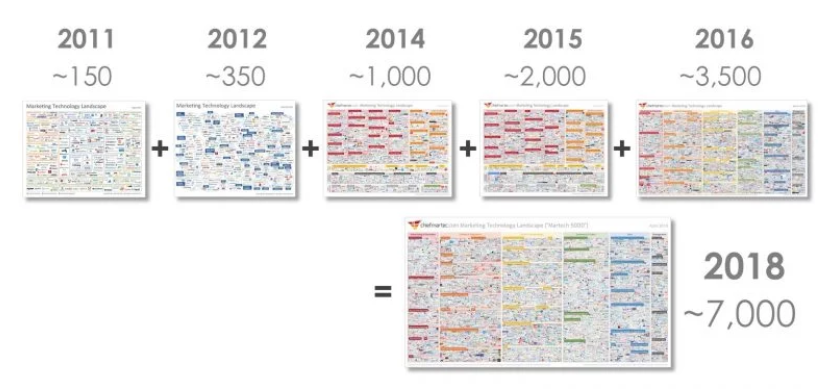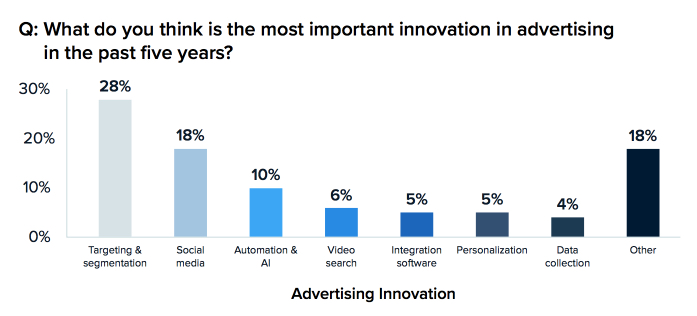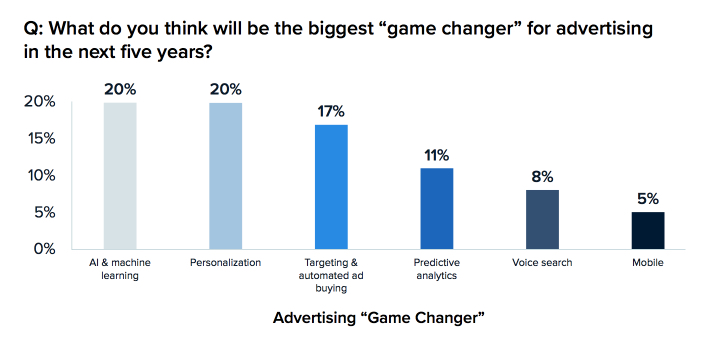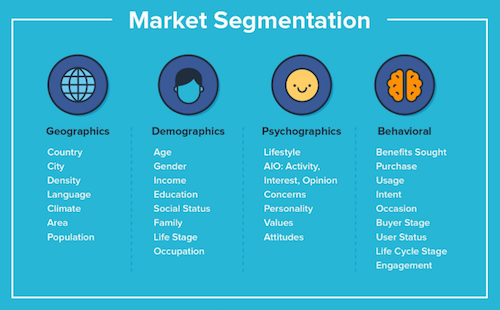When you are immersed in the digital marketing world, you must stay up to date with trends since the landscape is versatile and ever-changing. And now more than ever, it’s crucial that marketers reach prospects at the right place and the right time to make a lasting impression.
One resource you’ve probably seen is the Marketing Technology Landscape map by Scott Brinker. This useful infographic has been helping marketers keep up with the innovative marketing technology trends for several years now, prompting them to review their current marketing tech stack and take action to improve it.
See how drastically the infographic has changed over the last 7 years, from 2011 to 2018:

This is just one example to show how quickly the digital marketing landscape has changed in the last decade. To help you better understand why it’s imperative to stay on top of things like this, we produced The Digital Marketing Agency Research Report. In the report are the findings from over 200 digital marketing agencies that were surveyed about their:
This article will take a closer look at the final area: past and future innovative marketing strategies.
Advertising innovations that matter most
We asked survey participants a series of open-ended questions to uncover their opinions about the latest advertising trends and marketing innovations, plus their outlook on the future of the marketing industry. When respondents were asked about the most important marketing innovation in the past five years, here is how they responded:

When asked about their ideas regarding the biggest advertising “game changer” for the future, their responses looked like this:

Let’s look at the top two innovations from each one.
Targeting & segmentation
Improvements in targeting and segmentation are hailed as the top innovations in marketing over the past five years. That makes perfect sense, considering the increased need to personalize every customer interaction at the right place and right time.
An overwhelming amount of ads are served to consumers on a daily basis. Pair this with people’s minimal attention spans, and it’s easy to see how an increase in targeted ads with a specific purpose can help capture and hold their attention. While advertising tactics like negative keywords, Google Ads’ Audience Insights, and more can help run highly-targeted, singular-purpose ads, marketers must also understand the customer journey. This is the only way to offer prospects what appeals to them most, at the best times throughout their entire journey.
Market segmentation is just as important for targeting ideal customers. Rather than relying solely on mass marketing methods such as billboards, radio ads, and TV commercials, customer segmentation allows advertisers to filter out the masses and hone-in on exactly who they want to reach based on four main categories:

Segmenting your customers allows you to deliver much more personalized campaigns, which ultimately helps boost ROI. In fact, one study shows that marketers can experience up to 760% increase in email revenue by segmenting their email campaigns.
Social media
Innovations in social media are not about the shift from one popular platform to another. Rather, they’re about how people are changing their social media usage as a whole. While platforms were originally intended for peer interaction, that’s shifting as people are spending more and more time on social platforms today.
Rather than merely using them for social interaction and networking, users are now more interested in entertainment and new technology, such as videos and virtual reality.
Consider the following social media updates:
- Facebook Live and Instant Articles
- Instagram Stories and TV
- Twitter Moments
While these can still be used for interacting with peers, they’re used mainly for entertainment purposes — which is why many marketers are using them for advertising.
Consider ephemeral content, which is shared for up to 24 hours before it disappears from the platform. This content is found on Snapchat, Facebook, and Instagram, and now brands across these platforms are using it for real-time advertising purposes. Not only does having ephemeral content appear at the top of your follower’s feed help keep your brand top of mind, but it also compels followers to take fast action because it disappears quickly. This has become such an impactful business innovation, which advertisers are even creating completely separate ephemeral content marketing strategies.
AI & machine learning
Artificial intelligence (AI) has been steadily making its way into innovative marketing strategies, and will continue to be used in a wide range of marketing applications, such as content creation, voice and face recognition, chatbots, digital assistants, and more. AI will quickly become a marketing strategy norm because of its increasingly accurate ability to use meta-analysis of broad-spectrum data sets to make its own decisions and create a more interactive and personalized purchasing experience.
Many big-name companies like Google and Microsoft have already been steering in the direction of AI. Google, for example, is implementing a lot of its machine learning infrastructure to help marketers better understand their customers, and make more informed decisions with innovative marketing campaigns.
Machine-learning, natural language processing, and artificial intelligence are seeing more application programming interfaces with predictive algorithms. This is an important marketing innovation because it enables businesses to better predict their marketing spend and optimize their overall budget.
AI-driven personal assistants (Amazon’s Alexa, Google’s Assistant, Microsoft’s Cortana, and others) are continuing to make their way into consumers’ lives. Marketers are increasingly adding these virtual digital assistants (VDAs) to their strategies because of their ability to connect with consumers on a personal level and naturally interact with them at all points throughout their day-to-day lives. The VDA market alone is projected to increase from 1,016 million users in 2018 to 1,831 million by 2021:

The good news for businesses is that AI and machine learning technology will only continue to improve on a number of levels as time passes. Future innovations in voice recognition and more personalized services (many of which are based on data analysis of consumer behavior) are two important areas in which marketers can expect to continue seeing growth.
Personalization
Impersonalized email blasts and ad campaigns just aren’t cutting it anymore, as hyper-targeting and advertising personalization are taking over to provide an ideal experience for the customer, aligned with their specific needs and preferences.
Since consumers have so much choice and power in their behavior and buying these days — and want to do things on their own terms — it’s no longer about ads reaching consumers. Marketers must now find a way to “catch” their target customer at the exact right place and time.
This infographic shows how this precise advertising is achieved. Go here for the full infographic, including levels 4 and 5:

Personalization is one of the most critical aspects of marketing innovation and must be implemented along all stages of the sales funnel. Personalized post-click landing pages should be connected to every one of your personalized ad campaigns.
An outstanding 97% of marketers agree that personalization is one of the major keys to success in the digital marketing landscape, and an increasing number of businesses are investing larger chunks of their marketing budgets into the personalization process.
Get more in the report
The digital marketing industry is always evolving, technology continues to advance at a rapid pace, and clients are constantly expecting more and more from their agencies. While the recent marketing innovations above have helped, future innovations will take it to an even higher level.
All digital marketers must stay on top of the trends above to ensure that their marketing strategy remains relevant and is generating results. Marketers must have a clear vision and goals, always be learning, testing, and keep a somewhat flexible long-term strategy to incorporate some of these trends as necessary.
Download the Digital Advertising Trends in Agencies Report for more groundbreaking insights and ways to stay ahead of the competition.

See the Instapage Enterprise Plan in Action.
Demo includes AdMap™, Personalization, AMP,
Global Blocks, heatmaps & more.
